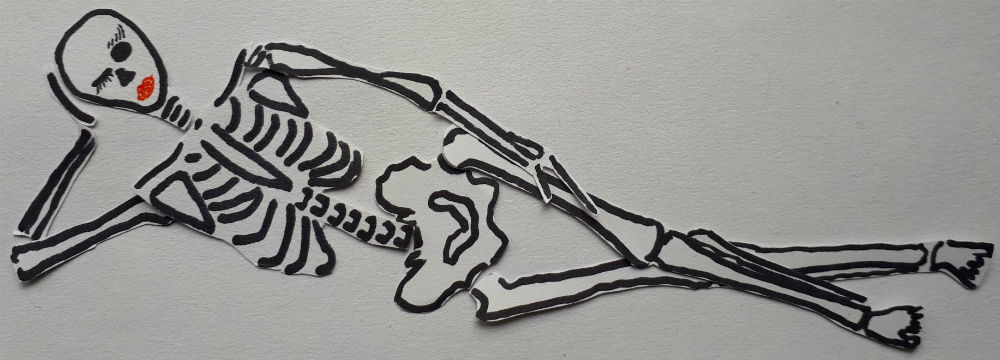Discover How I Helped These 2 Clients With Their Knee and Hip Pain By Improving 1 Simple Thing
I'd like to tell you about a couple of recent client sessions which I found particularly exciting! I enjoyed them because the changes I saw within the space of an hour were so obvious. Sometimes when I work with people the shifts are more vague. There's a sense that someone is different, but it's hard to pin down what or why... These shifts on the other hand were crystal clear.
My clients also noticed straight away that they were moving differently. Easier and with less pain. Over the next week, their pain levels and movement ability got better and better!
Results like these always satisfy me because I know what it's like to live with chronic pain. I remember the feelings of hopelessness, grief and shame. I also remember the feeling of relief when that burden finally lifted. Let's say helping people in pain is close to my heart.
In both of the cases I'm about to share, the symptoms were different. One had hip pain. The other had knee pain. However there was something that they both had in common. And that something was revealed in a simple test...
A Simple, Profound and Revealing Test I Use
There's a test I use often in my practice. The intention of this test is to reveal people's movement strategies. You'll learn more about what that means soon, but for now, understand it's about HOW someone does what they do.
This test specifically reveals, HOW they shift weight from one leg to the other.
This is an important test because shifting weight forms part of one particularly important human movement. You might say it's fundamental... Difficulty with it causes wide ranging and life altering ripple affects. Can you guess what it is?
That's right, it's WALKING!
Yes, in order to walk, we need to shift our weight to one leg while we swing the other leg forward. And then we shift weight onto the forward leg and swing the back leg forward.
A lot of the work I do on a day-to-day basis involves helping people improve the way they walk. The reason I aim to improve this is because it is a high leverage place to work.
Think about it. We take thousands of steps every day. If our movement strategy for walking is a tiny eensy weensy bit difficult, then that little bit gets multiplied thousands of times. It quickly grows into a pain monster. RarrRRRRrrrrRRRRrrr.
It also means that if we improve (moving from pain towards pleasure) the way we take a single step, that improvement also gets multiplied. This is perhaps more like a sexy monster. RRREEEOOOOWWWW ;-)
So you see, any little shift in people's walking has potential to make a big difference to their lives.
How To Do The Weight Shift Test
- Simply stand centered.
- Then SLOWLY shift your weight onto one leg and back to the centre.
- Then SLOWLY shift your weight onto the other leg and back again.
This test, to a trained eye, can reveal much about how people walk. It can provide brilliant starting points for useful explorations.
I'll ask myself questions like...What moves most? What moves least or not at all? Where is there hesitation? Where is the movement jerky? Plus many others...
You can also do this test yourself, just to see what you notice. You can try to FEEL it for yourself. You can also watch yourself in a full length mirror. Both is best.
Let's see what movement strategies my clients used in this test...
Client #1 Hip pain
This client practices Yoga and stays fairly active. However she's been struggling with hip pain for quite a while. She was having to sleep in funny positions just to get comfortable in bed.
When she goes to Yoga she makes a point of stretching out the muscles of her hip. However, usually the day afterwards, it becomes extremely painful.
I heard her use the word "frustrated" a number of times while she was telling me about all this.
Weight Shift Test Results
Let me first explain that when people shift weight there are a few key locations I'm watching and feeling for...
- The first rib (the highest rib up beneath your collar bones)
- The hip joint
- The ankle
In the skeleton images below these locations are highlighted in pink. Why pink? Because my 5 year old daughter insisted!
When my client shifted weight onto her left side (the non-painful hip) her first rib, hip and ankle all lined up vertically. She did this mostly by moving her hip left and then leaning with her torso using a straight spine. This was easy-peasy for her and probably the leg she spends more time standing on.
On the other side, her strategy was to move her pelvis way out to the right. The right hip joint ended up vertically to the right of her ankle and her first rib. It's like she was counterbalancing by throwing her hip out to the side. With this strategy, it is difficult for force to efficiently transfer through her skeleton which means that her muscles have to do extra work. Perhaps this has something to do with the pain?!?
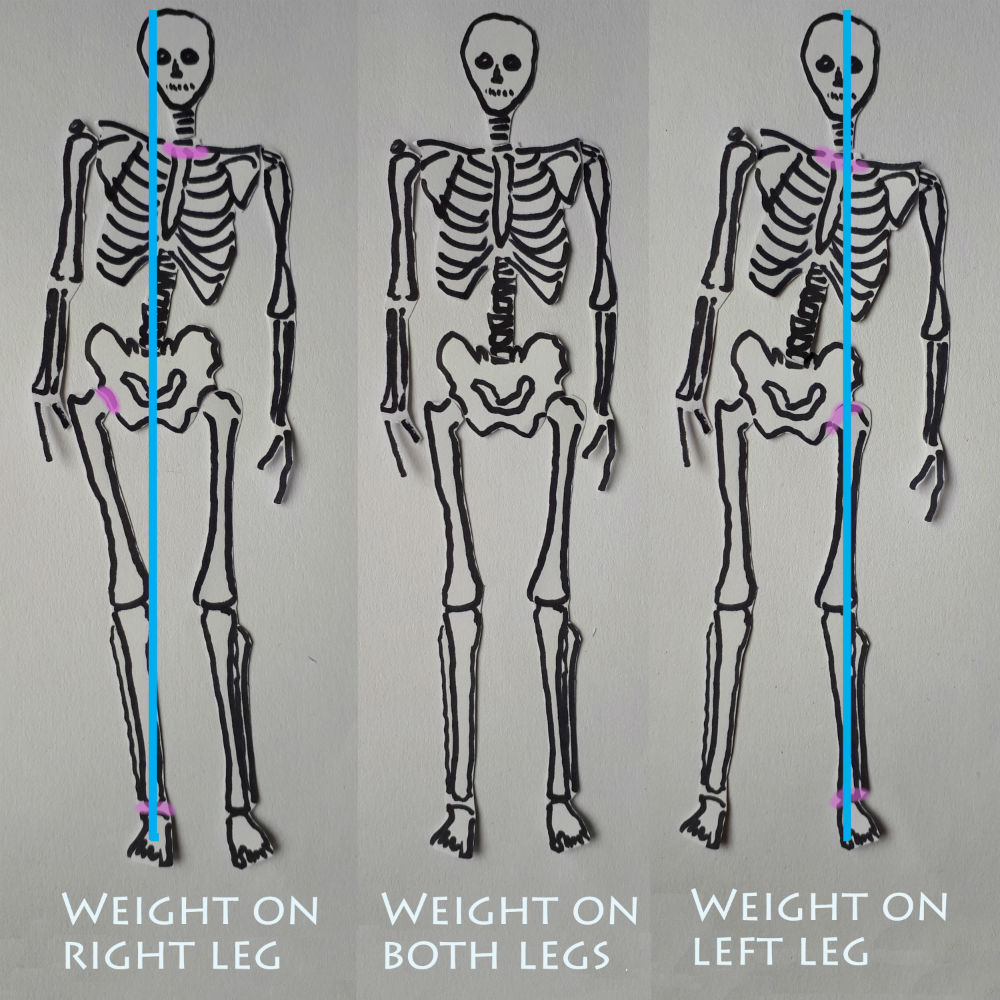
Now it might seem funny to see these differences side-by-side. But keep in mind these are unconscious (until they become conscious) patterns which we all have. Every one of us uses different strategies on each side of our body. Becoming aware of them allows us to start making changes.
The movements we explored together
I helped her learn how to let go of some of the habitual holding in her ribcage. This allowed her first rib a lot more freedom to shift to the right. I also reminded her about side-bending (think of the spine making the shape of the letter C) Once we re-tested, her whole system had re-organized itself and her strategy to the right looked much more like this...
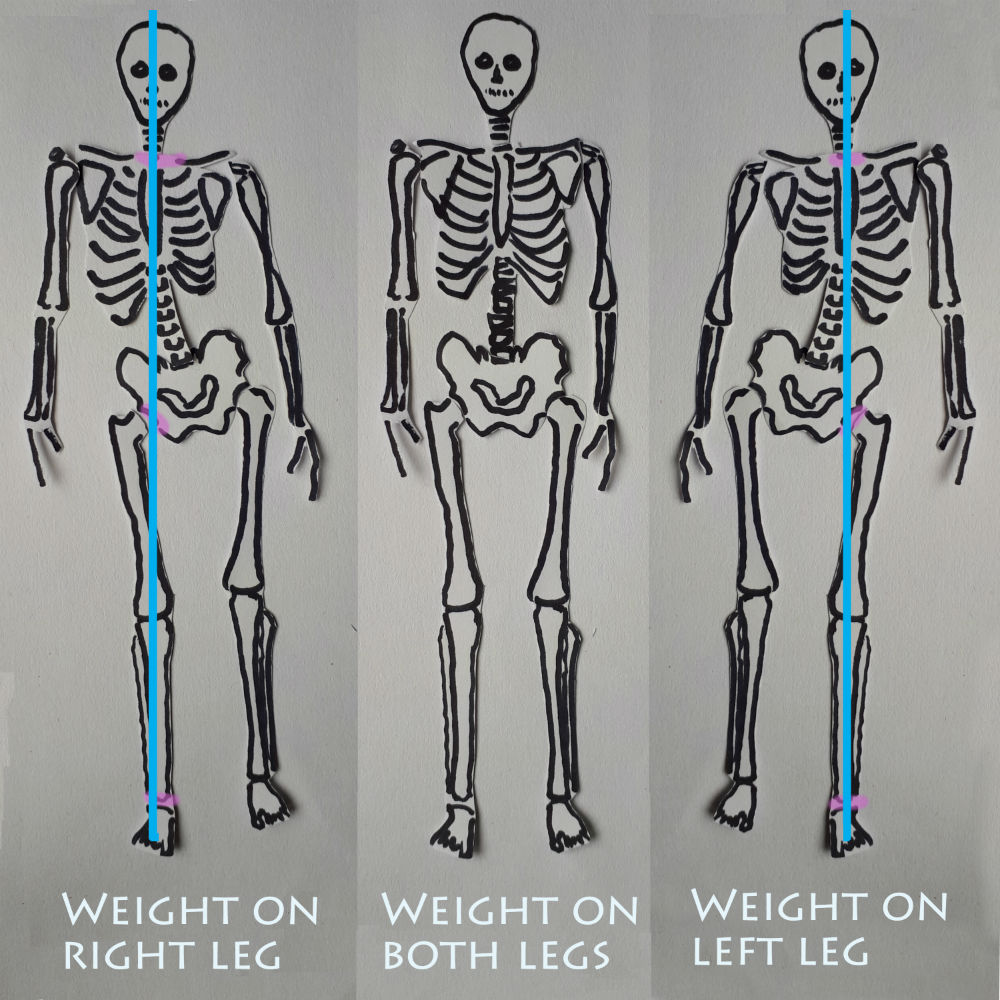
I would expect from seeing those 3 key points all lining up vertically that it would take a huge load off her muscles. Stuff should get easier.
Results?
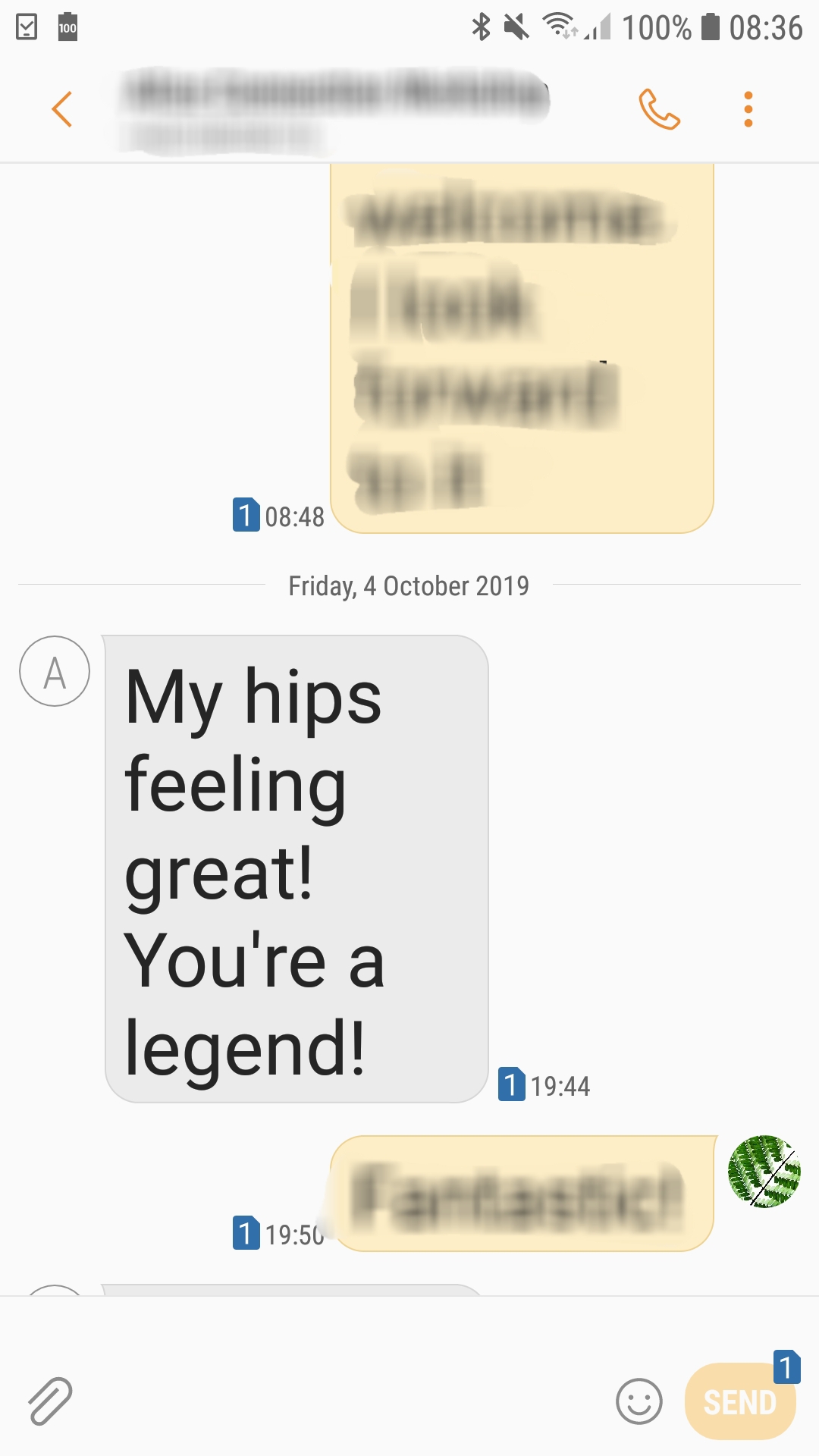
Client #2 Knee pain
This client couldn't pinpoint why his knee had suddenly become so painful. It didn't seem to come from a specific incident. His knee had mysteriously become stiff and difficult to bend.
This surprise nature of this injury sounded similar to the pain I had experienced in my own knee years ago. It feels like "It just came out of nowhere".
However, in cases like these, I think the truth is that we get many warning signals. But we don't always recognize them as such (especially in our culture of "no pain no gain"). Eventually if we ignore the signals for long enough, our system just cranks up the protesting!
Weight Shift Test Results
When shifting weight to his right side (non-painful knee side), he did quite a lot of turning in his upper torso to get his first rib, hip and ankle to line up vertically. The turning you'll have to imagine though (in the pictures below) because I didn't want to draw a whole new torso just to show that :-) The important thing is the vertical alignment of those key points.
On his left side his pelvis did not want to move to the side at all. It stayed in the centre and he had to move his first rib way out to the side through a combination of leaning and turning.
My guess is that he was having to use the muscles on his inner legs to account for the vertical misalignment of his skeleton. This could be a possible cause of the pain in his knee.
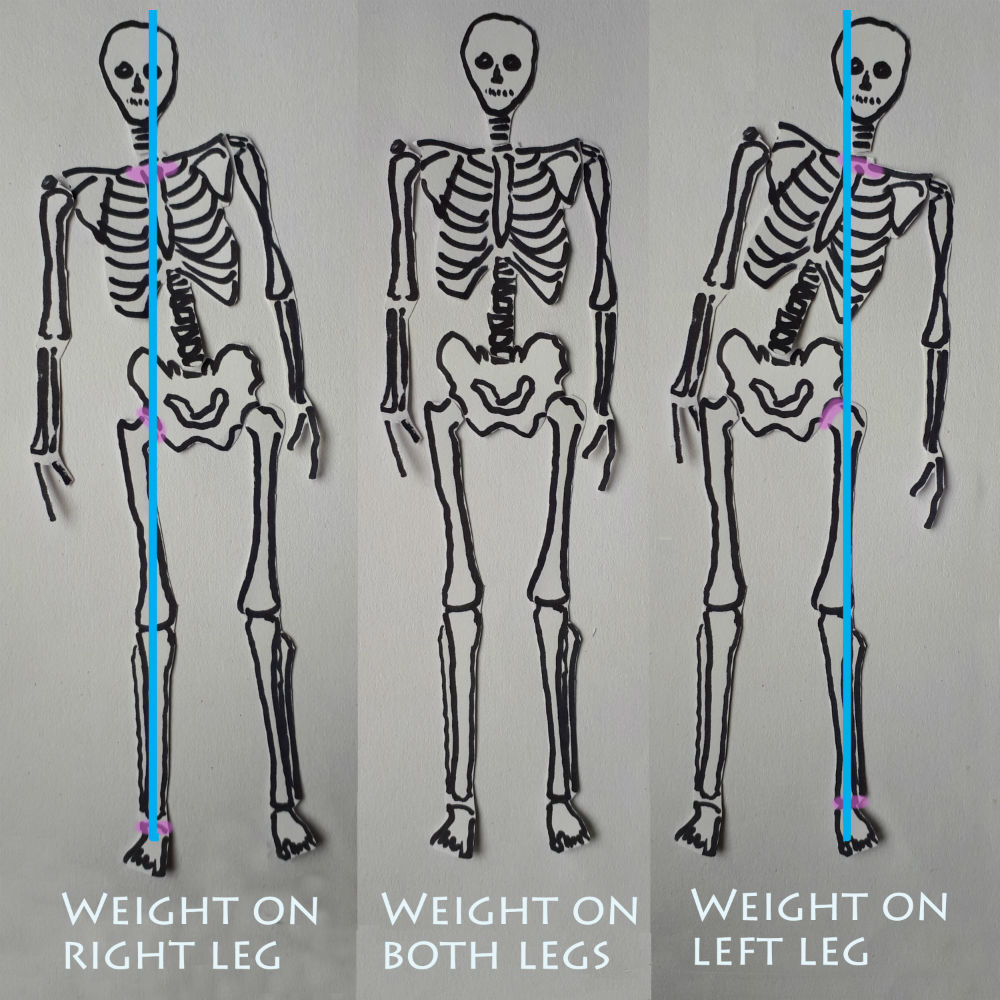
I also asked him how his sit bones (the bottom of his pelvis) were resting on the table as he sat there. He replied that they weren't clear, but felt different to one another.
Our movement explorations
In this case too, I helped him learn how to let go of some of the habitual holding in his ribcage. This allowed him to free up that first rib and learn how to side bend again.
Same picture as the first case, the movement was more like this afterwards.

Before he got up to walk around he noticed that his sit bones were clearly and evenly contacting the table. This is a good sign that his walking would have changed.
Results?
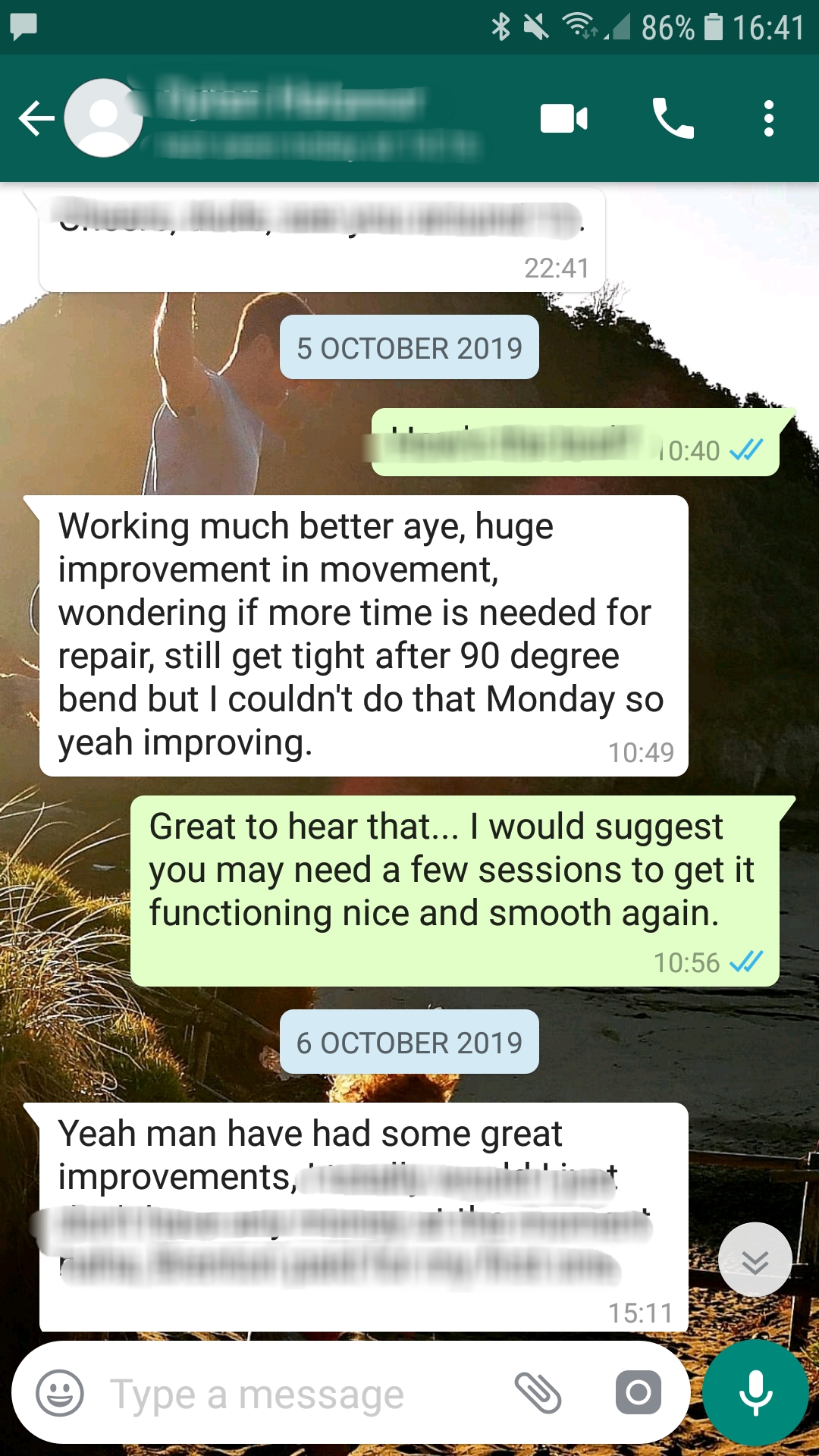
Key Takeaway - Move Through Pain By Learning Something New
Don't you think it's fascinating how...
Both of these clients had pain in different places, yet both of them felt relief after re-learning how to sidebend.
In both cases I barely even touched their painful spots. Yet they improved.
This goes completely in the face of conventional thinking. "Find the problem, fix the problem."
Perhaps it's time for a new approach? "Forget the problem, learn something new"
By learning something new, I...
- Become a more whole, adaptable and resilient human.
- Gain abilities and options in my thinking and moving.
- Replace pain and suffering with ease and pleasure.
And life get's more...
...sexy!
